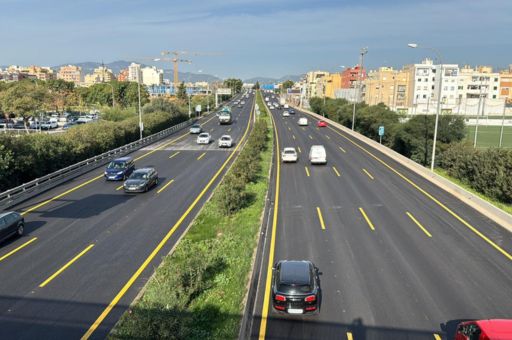With a budget of 12 million euros, the road surface of the Vía de Cintura has been improved after a 20-year period without any intervention. The stretch between Estadio Balear and the access towards Inca (2.4 kilometres) will be downgraded from a motorway to a conventional four-lane road, with a maximum speed limit of 90 km/h.
The improvement works on road safety and pavement reinforcement on the Vía de Cintura, carried out by the Consell de Mallorca, are scheduled to be completed on June 10. The works aim to enhance traffic flow and reduce congestion. The project began in October and included high-quality asphalt resurfacing and the replacement of safety barriers along 8 kilometres in both directions.
Fernando Rubio, the Conseller of Territory, Mobility, and Infrastructure of the Consell de Mallorca, explained that this is one of the most significant actions in the Palma Access Plan. No such works had been done in over 20 years on Mallorca’s most heavily trafficked road, with an average daily traffic volume (ADT) of 180,000 vehicles.
TDB keeps you informed. Follow us on: Facebook, Twitter and Instagram
Works on the Vía de Cintura to Finish on June 10, with More Lanes to Improve Traffic Flow and Safety
Thanks to these reforms, an additional lane has been added to increase capacity on the Vía de Cintura. Specifically, the section under the Can Blau roundabout now has three lanes, and the stretch between Estadio Balear and the Inca motorway junction now has four lanes over 2.4 kilometres. This intervention also changes the road classification. Technical reports and regulations support this change: the section will become a multi-lane conventional road with a maximum speed limit of 90 km/h, no longer classified as a motorway. It will feature two lanes of 3 meters and two of 3.15 meters, all complying with safety standards, according to the Consell’s technical assessments.
“The technical staff of the Consell’s Infrastructure Department have determined that the priority right now is to improve traffic flow. With these four lanes, we’ll be able to handle more vehicles and, as a result, reduce congestion. This section will be marked in white, while the rest of the Vía de Cintura will remain marked in blue,” said Fernando Rubio.
The Conseller emphasised that “90% of the Vía de Cintura will continue with a speed limit of 100 km/h, which is considered effective by experts. This specific section will have a limit of 90 km/h, and inside the tunnels, it will be 80 km/h.”
PROJECT FEATURES
In addition to the extra lanes, the project involved resurfacing 8 kilometres of road with high-quality asphalt and improving the pavement on entry and exit ramps. All metal safety barriers were replaced with concrete ones, which are considered safer according to current regulations. Bridge structures and safety features along the Vía de Cintura were also reinforced.
Finally, the access from the airport motorway to the Vía de Cintura was reorganised, now providing two access lanes instead of just one in the direction of Andratx. The ramps leading up to the Génova tunnel were also resurfaced and improved.
